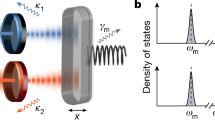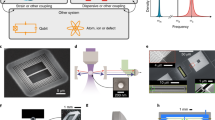Abstract
Interfacing a single photon with another quantum system is a key capability in modern quantum information science. It allows quantum states of matter, such as spin states of atoms1,2, atomic ensembles3,4 or solids5, to be prepared and manipulated by photon counting and, in particular, to be distributed over long distances. Such light–matter interfaces have become crucial to fundamental tests of quantum physics6 and realizations of quantum networks7. Here we report non-classical correlations between single photons and phonons—the quanta of mechanical motion—from a nanomechanical resonator. We implement a full quantum protocol involving initialization of the resonator in its quantum ground state of motion and subsequent generation and read-out of correlated photon–phonon pairs. The observed violation of a Cauchy–Schwarz inequality is clear evidence for the non-classical nature of the mechanical state generated. Our results demonstrate the availability of on-chip solid-state mechanical resonators as light–matter quantum interfaces. The performance we achieved will enable studies of macroscopic quantum phenomena8 as well as applications in quantum communication9, as quantum memories10 and as quantum transducers11,12.
This is a preview of subscription content, access via your institution
Access options
Subscribe to this journal
Receive 51 print issues and online access
$199.00 per year
only $3.90 per issue
Buy this article
- Purchase on Springer Link
- Instant access to full article PDF
Prices may be subject to local taxes which are calculated during checkout



Similar content being viewed by others
References
Wilk, T., Webster, S. C., Kuhn, A. & Rempe, G. Single-atom single-photon quantum interface. Science 317, 488–490 (2007)
Stute, A. et al. Quantum-state transfer from an ion to a photon. Nature Photon. 7, 219–222 (2013)
Kuzmich, A. et al. Generation of nonclassical photon pairs for scalable quantum communication with atomic ensembles. Nature 423, 731–734 (2003)
van der Wal, C. H. et al. Atomic memory for correlated photon states. Science 301, 196–200 (2003)
Yılmaz, S. T., Fallahi, P. & Imamoğlu, A. Quantum-dot-spin single-photon interface. Phys. Rev. Lett. 105, 033601 (2010)
Hensen, B. et al. Loophole-free Bell inequality violation using electron spins separated by 1.3 kilometres. Nature 526, 682–686 (2015)
Kimble, H. J. The quantum internet. Nature 453, 1023–1030 (2008)
Romero-Isart, O. Quantum superposition of massive objects and collapse models. Phys. Rev. A 84, 052121 (2011)
Stannigel, K., Rabl, P., Sørensen, A. S., Zoller, P. & Lukin, M. D. Optomechanical transducers for long-distance quantum communication. Phys. Rev. Lett. 105, 220501 (2010)
Chang, D. E., Safavi-Naeini, A. H., Hafezi, M. & Painter, O. Slowing and stopping light using an optomechanical crystal array. New J. Phys. 13, 023003 (2011)
Barzanjeh, S., Abdi, M., Milburn, G. J., Tombesi, P. & Vitali, D. Reversible optical-to-microwave quantum interface. Phys. Rev. Lett. 109, 130503 (2012)
Bochmann, J., Vainsencher, A., Awschalom, D. D. & Cleland, A. N. Nanomechanical coupling between microwave and optical photons. Nature Phys. 9, 712–716 (2013)
Wallquist, M., Hammerer, K., Rabl, P., Lukin, M. & Zoller, P. Hybrid quantum devices and quantum engineering. Phys. Scr. T137, 014001 (2009)
Poot, M. & van der Zant, H. S. J. Mechanical systems in the quantum regime. Phys. Rep. 511, 273–335 (2012)
Aspelmeyer, M., Kippenberg, T. J. & Marquardt, F. Cavity optomechanics. Rev. Mod. Phys. 86, 1391–1452 (2014)
O’Connell, A. D. et al. Quantum ground state and single-phonon control of a mechanical resonator. Nature 464, 697–703 (2010)
Meenehan, S. M. et al. Pulsed excitation dynamics of an optomechanical crystal resonator near its quantum ground state of motion. Phys. Rev. X 5, 041002 (2015)
Teufel, J. D. et al. Sideband cooling of micromechanical motion to the quantum ground state. Nature 475, 359–363 (2011)
Chan, J. et al. Laser cooling of a nanomechanical oscillator into its quantum ground state. Nature 478, 89–92 (2011)
Palomaki, T. A., Teufel, J. D., Simmonds, R. W. & Lehnert, K. W. Entangling mechanical motion with microwave fields. Science 342, 710–713 (2013)
Wollman, E. E. et al. Quantum squeezing of motion in a mechanical resonator. Science 349, 952–955 (2015)
Safavi-Naeini, A. H. & Painter, O. Proposal for an optomechanical traveling wave phonon–photon translator. New J. Phys. 13, 013017 (2011)
Safavi-Naeini, A. H., Alegre, T. P. M., Winger, M. & Painter, O. Optomechanics in an ultrahigh-Q two-dimensional photonic crystal cavity. Appl. Phys. Lett. 97, 181106 (2010)
Duan, L. M., Lukin, M. D., Cirac, J. I. & Zoller, P. Long-distance quantum communication with atomic ensembles and linear optics. Nature 414, 413–418 (2001)
Cabrillo, C., Cirac, J. I., García-Fernández, P. & Zoller, P. Creation of entangled states of distant atoms by interference. Phys. Rev. A 59, 1025–1033 (1998)
Lee, K. C. et al. Entangling macroscopic diamonds at room temperature. Science 334, 1253–1256 (2011)
Wu, L.-A., Kimble, H. J., Hall, J. L. & Wu, H. Generation of squeezed states by parametric down conversion. Phys. Rev. Lett. 57, 2520–2523 (1986)
Cohen, J. D. et al. Phonon counting and intensity interferometry of a nanomechanical resonator. Nature 520, 522–525 (2015)
Clauser, J. F. Experimental distinction between the quantum and classical field-theoretic predictions for the photoelectric effect. Phys. Rev. D 9, 853–860 (1974)
Förtsch, M. et al. A versatile source of single photons for quantum information processing. Nature Commun. 4, 1818 (2013)
Chan, J. et al. Optimized optomechanical crystal cavity with acoustic radiation shield. Appl. Phys. Lett. 101, 081115 (2012)
Meenehan, S. M. et al. Silicon optomechanical crystal resonator at millikelvin temperatures. Phys. Rev. A 90, 011803(R) (2014)
Fiore, V. et al. Storing optical information as a mechanical excitation in a silica optomechanical resonator. Phys. Rev. Lett. 107, 133601 (2011)
Verhagen, E., Deléglise, S., Weis, S., Schliesser, A. & Kippenberg, T. J. Quantum-coherent coupling of a mechanical oscillator to an optical cavity mode. Nature 482, 63–67 (2012)
Andrews, R. W. et al. Bidirectional and efficient conversion between microwave and optical light. Nature Phys. 10, 321–326 (2014)
Bagci, T. et al. Optical detection of radio waves through a nanomechanical transducer. Nature 507, 81–85 (2014)
Akram, U., Kiesel, N., Aspelmeyer, M. & Milburn, G. J. Single-photon opto-mechanics in the strong coupling regime. New J. Phys. 12, 083030 (2010)
Natarajan, C. M., Tanner, M. G. & Hadfield, R. H. Superconducting nanowire single-photon detectors: physics and applications. Supercond. Sci. Technol. 25, 063001 (2012)
Hofer, S. G., Wieczorek, W., Aspelmeyer, M. & Hammerer, K. Quantum entanglement and teleportation in pulsed cavity optomechanics. Phys. Rev. A 84, 052327 (2011)
Mandel, L. & Wolf, E. Optical Coherence and Quantum Optics (Cambridge Univ. Press, 1995)
Sangouard, N., Simon, C., de Riedmatten, H. & Gisin, N. Quantum repeaters based on atomic ensembles and linear optics. Rev. Mod. Phys. 83, 33–80 (2011)
Zoller, P., Cirac, J. I., Duan, L. & Garcia-Ripoll, J. J. in Quantum Entanglement and Information Processing (eds Estève, D., Raimond, J.-M. & Dalibard, J.) Session 79 of Lecture Notes of the Les Houches Summer School 2003 Course 4 (Elsevier, 2004)
Vanner, M. R., Aspelmeyer, M. & Kim, M. S. Quantum state orthogonalization and a toolset for quantum optomechanical phonon control. Phys. Rev. Lett. 110, 010504 (2013)
Galland, C., Sangouard, N., Piro, N., Gisin, N. & Kippenberg, T. J. Heralded single-phonon preparation, storage, and readout in cavity optomechanics. Phys. Rev. Lett. 112, 143602 (2014)
Zhao, B. et al. A millisecond quantum memory for scalable quantum networks. Nature Phys. 5, 95–99 (2009)
Acknowledgements
We thank K. Hammerer and S. Hofer for discussions, and T. Graziosi, J. Hill, J. Hoelscher-Obermaier, Y. Liu, L. Procopio, A. Safavi-Naeini, E. Schafler, G. Steele and W. Wieczorek for experimental support. We acknowledge assistance from the Kavli Nanolab Delft, in particular from M. Zuiddam and F. Dirne. This project was supported by the European Commission (cQOM, SIQS, IQUOEMS), a Foundation for Fundamental Research on Matter (FOM) Projectruimte grant (15PR3210), the Vienna Science and Technology Fund WWTF (ICT12-049), the European Research Council (ERC CoG QLev4G), and the Austrian Science Fund (FWF) under projects F40 (SFB FOQUS) and P28172. R.R. is supported by the FWF under project W1210 (CoQuS) and is a recipient of a DOC fellowship of the Austrian Academy of Sciences at the University of Vienna.
Author information
Authors and Affiliations
Contributions
All authors contributed substantially to the content of this paper.
Corresponding authors
Ethics declarations
Competing interests
The authors declare no competing financial interests.
Extended data figures and tables
Extended Data Figure 1 Optomechanical device.
Shown is a scanning electron microscope image of a set of nanobeams, which are fabricated in silicon, as described in the text. Light is coupled into the central, adiabatically tapered waveguide through a lensed optical fibre (not shown) from the left of the image. The field then evanescently couples to each nanobeam (top and bottom). The two devices have slightly different resonance frequency, which makes it possible to distinguish them.
Extended Data Figure 2 Detailed experimental set-up.
See Methods section ‘Set-up’ for a description.
Extended Data Figure 3 Pump-probe measurement of the mechanical response.
We send in a brief, intense blue-detuned optical pulse (pump) and measure the mechanical response via a red-detuned optical probe pulse as a function of pump-probe time delay (δt). a, Long-term mechanical response. The result fits well with a simple exponential decay (red dashed line; see equation in the plot) with a damping time constant (Td) of 34.4 μs. The inset shows the same data/fit with a logarithmic scale on the x axis. CAS,0 is the extrapolated CAS (δt = 0). b, Short-term mechanical response. The data are fitted to a simple exponential curve (green dashed line; see equation in the plot). The fitted time constant (τd) is 0.37 μs. The fit curve of the long-term response (red dashed line) projected to 0-μs delay is also shown for comparison. Because the pump-pulse energies were five times stronger than those of the write pulses in the correlation experiment, it is expected that the delayed heating occurs on a longer timescale, owing to the temperature dependence of the thermal conductivity of silicon32. Error bars in a and b represent a 68% confidence interval.
Rights and permissions
About this article
Cite this article
Riedinger, R., Hong, S., Norte, R. et al. Non-classical correlations between single photons and phonons from a mechanical oscillator. Nature 530, 313–316 (2016). https://doi.org/10.1038/nature16536
Received:
Accepted:
Published:
Issue Date:
DOI: https://doi.org/10.1038/nature16536
This article is cited by
-
An integrated microwave-to-optics interface for scalable quantum computing
Nature Nanotechnology (2024)
-
Measurement-induced collective vibrational quantum coherence under spontaneous Raman scattering in a liquid
Nature Communications (2023)
-
Active-feedback quantum control of an integrated low-frequency mechanical resonator
Nature Communications (2023)
-
Direct characterization of shear phonons in layered materials by mechano-Raman spectroscopy
Nature Photonics (2023)
-
Phase-controlled asymmetric optomechanical entanglement against optical backscattering
Science China Physics, Mechanics & Astronomy (2023)
Comments
By submitting a comment you agree to abide by our Terms and Community Guidelines. If you find something abusive or that does not comply with our terms or guidelines please flag it as inappropriate.



